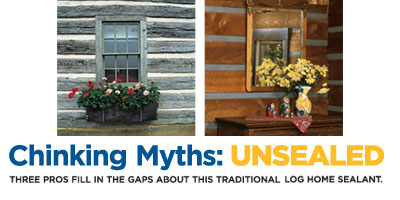
| Jim McCain President Weatherall Charlestown, Indiana 800-367-7068 MYTH 1: Chinking is not necessary — it's just for visual appeal. When properly applied, chinking drastically improves a home's energy efficiency by reducing heat loss where the logs meet. In fact, chinking can boost the R-value (a measure of heat transfer) of a chink joint to almost the R-value at the log's center. MYTH 2: Chinking will not last. This was basically true of the older cement-based chinking materials, which had relatively low bond strength and no elasticity. Today's "elastomeric" chinking materials are more flexible — so as logs shift and settle, they are far less likely to tear or come loose. On a conservative estimate, chinking lasts about 40-50 years. MYTH 3: Chinking does not need a backing rod. A correctly designed backing rod provides a non-adhering surface. That means the chinking should adhere only to the logs above and below the chinking joint, in two thin lines. This is known as "two-point adhesion" and allows the chinking to shift with the logs. Backing rods also provide significant joint insulation, reduce the amount of chinking required, and prevent the chinking from getting deep into the joint where it will experience movement beyond its elastic limits. If the joint is too shallow for a backing rod, caulk is typically used instead. |
Rich Dunstan President Perma-Chink 800-548-1231 MYTH 1: Chinking comes in just one mortar color. Some people think chinking always looks like "zebra stripes" — bands of light-colored material between dark logs. But most chinking manufacturers offer several color options, including traditional hues that stand out from the logs and modern hues designed to match your logs. Some manufacturers offer tinting products that can give you even more creative color options. MYTH 2: Chinking can only be applied in weather that is 40 degrees or warmer. Chinking is a water-based polymer that can freeze before drying. Fortunately, some chinking materials are not affected by freezing. The curing process simply continues when the chinking thaws out (check with the manufacturer). A bigger concern is excessive heat, which can super-cure the chinking. Imagine a new cement sidewalk drying in the hot summer sun. When the cement dries too quickly, it seriously reduces its strength — and the same principal applies to chinking. MYTH 3: Synthetic chinking can't be applied over older mortar chinking. Yesterday's mortar-based chinking compounds were inflexible and sometimes cracked as logs settled. Today's more flexible chinking (which shifts with the logs) can be applied over old cracked mortar. You must first fill in any gaps in the mortar with a backing rod, so that the surface of the backing rod is level with that of the original chinking. Next, cover the joint with bond breaker tape. Finally, apply a full-thickness application of the new chinking according to its directions, extending it 3/8 inch beyond both edges of the tape and mortar. |
Debbie Bassett National Marketing Manager Sashco Brighton, Colorado 800-767-5656 MYTH 1: Chinking can be the same thickness no matter how wide the chink joint. The thickness should vary with the joint width. Aim for a thickness of at least half the joint's width. For example, the minimum thickness of the chinking for a 1/2-inch-wide joint is 1/4 inch. However, the thickness should never be more than 1/2 inch thick (even if the chink joint is wider than 1 inch). A thickness greater than 1/2 inch may limit the chinking's ability to flex — possibly causing it to separate from the logs as they shift. MYTH 2: The diameter of the logs does not affect the size of the chink joint. The larger your home's logs, the more settling movement you can expect. A good rule of thumb is to allow chink joints that are 15 percent of the diameter of the logs. For example, if you are building with 18-inch logs, the chink joint should be about 2.5 to 2.75 inches wide in order to accommodate them as they settle. MYTH 3: If chinking splits in the center or pulls away from logs, then it's defective. If chinking is applied according to the manufacturer's directions, tearing or loss of adhesion is unlikely but not impossible. Sometimes there are "maverick" logs on a structure with higher moisture content that move more than the others — a perfectly normal scenario that can result in torn or loose chinking (most likely in a log home's first two to three years). If chinking tears in the center, simply clean the affected area and reapply new chinking according to the directions. If it pulls away from the logs, however, you should cut out the loose sections, inspect and replace the backing rod as needed — then clean the area and reapply the chinking. |











